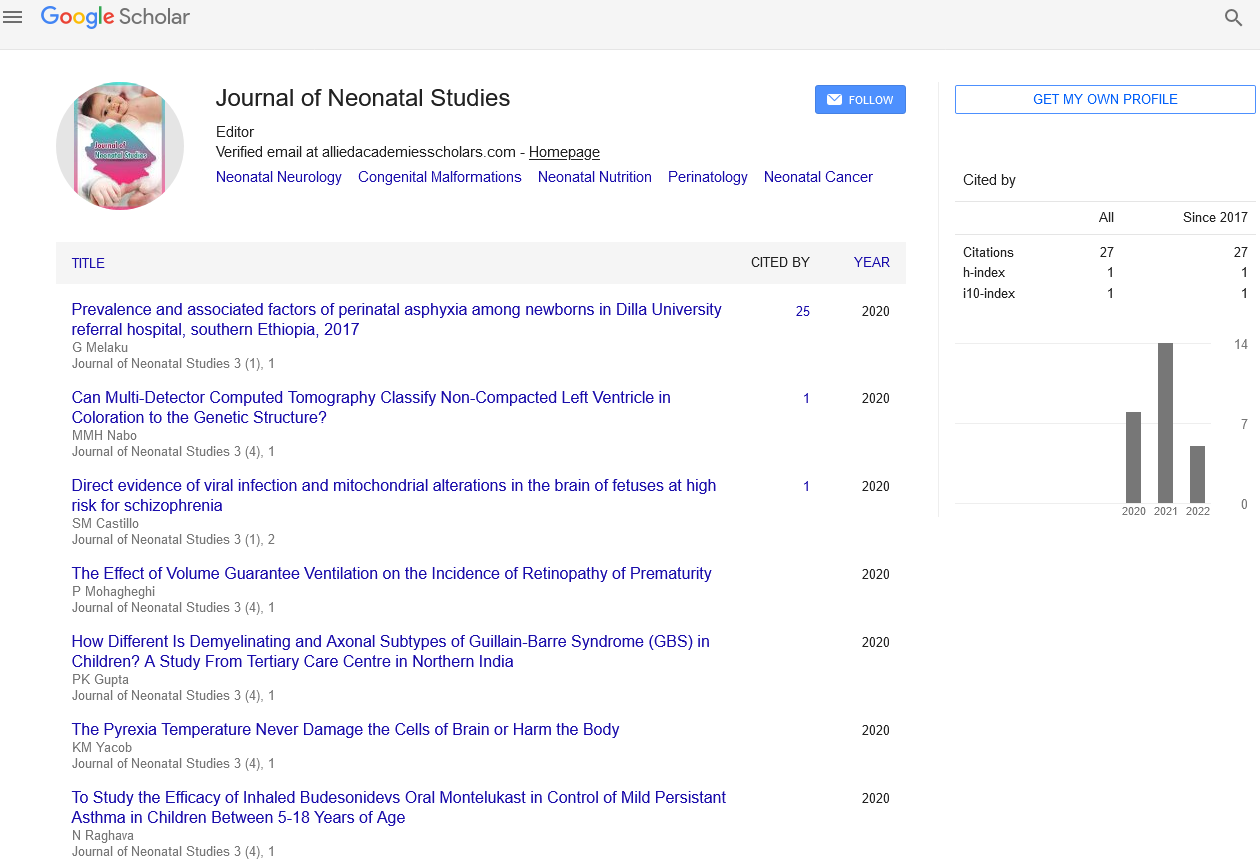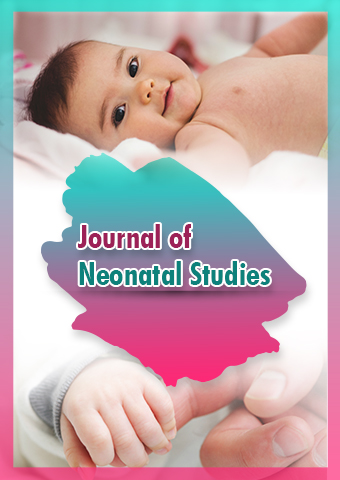Mini Review - Journal of Neonatal Studies (2023) Volume 6, Issue 3
Neonatal Mortality: Understanding the Challenges and Pursuing Solutions
Fanos Vassilios*
Neonatal Intensive Care Unit, Puericulture Institute and Neonatal Section, Azienda Ospedaliera Universitaria, University of Cagliari, Monserrato, Cagliari, Italy
Neonatal Intensive Care Unit, Puericulture Institute and Neonatal Section, Azienda Ospedaliera Universitaria, University of Cagliari, Monserrato, Cagliari, Italy
E-mail: vassillosfan@edu.it
Received: 01-June-2023, Manuscript No. jns-23-104257; Editor assigned: 2-June-2023, PreQC No. jns-23- 104257(PQ); Reviewed: 15-June- 2023, QC No. jns-23-104257; Revised: 23-June-2023, Manuscript No. jns-23- 104257(R); Published: 30-June-2023; DOI: 10.37532/jns.2023.6(3).64-66
Abstract
Neonatal mortality, defined as the death of an infant within the first 28 days of life, remains a pressing global health issue. Despite significant progress in reducing child mortality, neonatal deaths continue to account for a substantial proportion of child deaths worldwide. This article aims to shed light on the challenges associated with neonatal mortality, explore its causes, and discuss potential solutions to improve newborn survival rates.
Keywords
Neonatal mortality • Infant • Global health • Neonatal death • Potential solutions
Introduction
The global burden of neonatal mortality
Neonatal mortality represents a significant burden on global health. According to the World Health Organization (WHO), an estimated 2.4 million infants die within the first month of life each year, accounting for nearly half of all under-five deaths. The majority of these deaths occur in low- and middle-income countries, where access to quality healthcare services and resources for newborn care may be limited [1].
Causes of neonatal mortality
Preterm birth complications: Prematurity is a leading cause of neonatal mortality. Preterm infants, born before 37 weeks of gestation, are at higher risk of respiratory distress syndrome, infections, and other complications that can result in death.
Infections: Neonatal sepsis, pneumonia, and other infectious diseases significantly contribute to neonatal mortality. Inadequate prenatal care, unhygienic birthing conditions, and limited access to vaccines and antibiotics increase the vulnerability of newborns to infections.
Birth asphyxia: Oxygen deprivation during childbirth can lead to birth asphyxia, causing brain damage and potentially fatal consequences if not promptly managed. Lack of skilled birth attendants, limited access to emergency obstetric care, and delays in timely interventions contribute to birth asphyxia-related deaths [2].
Congenital anomalies: Structural or functional abnormalities present at birth can increase the risk of neonatal mortality. Congenital heart defects, neural tube defects, and genetic disorders are examples of conditions that may result in early infant death.
Poor maternal health: Maternal factors such as maternal malnutrition, anemia, and infections can have a direct impact on neonatal health and survival. Maternal health conditions, if left unaddressed, can increase the risk of adverse neonatal outcomes.
Addressing neonatal mortality
Improving antenatal care: Strengthening antenatal care services is crucial to identify highrisk pregnancies, provide necessary interventions, and educate expectant mothers about proper nutrition, hygiene, and warning signs. Regular check-ups, early detection of complications, and appropriate management of maternal health conditions can significantly reduce neonatal mortality [3].
Enhancing skilled birth attendance: Ensuring that all births are attended by skilled healthcare professionals, such as midwives or obstetricians, can contribute to better outcomes. Skilled birth attendants can manage complications during delivery, perform neonatal resuscitation, and provide immediate postnatal care.
Promoting neonatal resuscitation and essential newborn care: Training healthcare providers in neonatal resuscitation techniques and the provision of essential newborn care is essential. Timely interventions to address birth asphyxia, maintain newborn body temperature, promote early initiation of breastfeeding, and prevent infections can make a significant difference in neonatal survival rates.
Strengthening neonatal intensive care: Enhancing access to quality Neonatal Intensive Care Units (NICUs) is vital, particularly for preterm and critically ill infants. Adequate staffing, essential medical equipment, and advanced interventions in NICUs can improve outcomes for neonates requiring specialized care.
Community-based interventions: Community health workers can play a crucial role in identifying pregnant women, promoting maternal and neonatal health practices, and referring high-risk cases to appropriate healthcare facilities [4, 5].
Discussion
Understanding and addressing neonatal mortality
Neonatal mortality, the death of infants within the first 28 days of life, remains a significant global health concern. Despite notable progress in reducing child mortality, neonatal deaths continue to account for a substantial portion of under-five mortality worldwide. This discussion aims to delve into the complexities surrounding neonatal mortality, examine its causes, and explore potential strategies to reduce infant deaths in the crucial early days of life.
Magnitude of neonatal mortality
Neonatal mortality represents a significant burden on global health. According to the World Health Organization (WHO), an estimated 2.4 million neonates die each year, accounting for nearly 47% of under-five deaths globally. The majority of these deaths occur in low- and middle-income countries, where access to quality healthcare and essential resources for newborn care may be limited [6].
Causes of neonatal mortality
Preterm birth complications: Prematurity is a leading cause of neonatal mortality. Infants born before 37 weeks of gestation face higher risks of respiratory distress syndrome, infections, and other complications that can lead to death. Adequate prenatal care, including interventions to prevent preterm labor, antenatal corticosteroids, and improved neonatal intensive care, can help reduce mortality associated with preterm birth.
Infections: Infections play a significant role in neonatal mortality. Neonatal sepsis, pneumonia, and other infectious diseases can lead to life-threatening conditions. Factors such as unhygienic birthing practices, inadequate prenatal care, limited access to vaccines, and antibiotics contribute to the vulnerability of newborns to infections. Strengthening infection prevention and control measures, promoting breastfeeding, and ensuring clean birthing environments can help combat neonatal infections [7, 8].
Birth asphyxia: Birth asphyxia, characterized by oxygen deprivation during childbirth, is a critical cause of neonatal mortality. Lack of skilled birth attendants, delays in access to emergency obstetric care, and inadequate resuscitation efforts contribute to the burden of birth asphyxia-related deaths. Training healthcare providers in neonatal resuscitation techniques, improving access to skilled birth attendants, and raising awareness about birth preparedness can significantly reduce mortality due to birth asphyxia.
Congenital anomalies: Congenital anomalies, including structural or functional abnormalities present at birth, contribute to neonatal mortality. These anomalies can be caused by genetic factors, exposure to environmental teratogens, or a combination of both. Timely prenatal diagnosis, access to specialized care, and appropriate management can improve outcomes for infants with congenital anomalies.
Maternal health factors: Maternal health conditions have a direct impact on neonatal mortality. Maternal malnutrition, anemia, infections, and other health issues can increase the risk of adverse neonatal outcomes. Addressing maternal health through comprehensive antenatal care, ensuring proper nutrition and supplementation, and managing maternal infections effectively can positively influence neonatal survival rates [9, 10].
Conclusion
Addressing neonatal mortality
Strengthening antenatal care: Enhancing antenatal care services is crucial for identifying high-risk pregnancies, providing necessary interventions, and educating expectant mothers. Regular check-ups, early detection and management of complications, promotion of proper nutrition and hygiene, and educating mothers about danger signs are essential components of effective antenatal care.
Promoting skilled birth attendance: Ensuring that all births are attended by skilled healthcare professionals, such as midwives or obstetricians, is critical. Skilled birth attendants can effectively manage complications during delivery, perform neonatal resuscitation, provide immediate postnatal care, and refer infants with complications to higher-level care facilities.
Acknowledgement
None
Conflict of Interest
None
References
- Eddy MC, Jan De Beur SM, Yandow SM et al. Deficiency of the alpha-subunit of the stimulatory G protein and severe extraskeletal ossification. J Bone Miner Res. 15, 2074-2083 (2000).
- Friedenstein AJ. (1976) Precursor cells of mechanocytes. Int Rev Cytol. 47, 327-359 (1976).
- Owen M. Marrow stromal stem cells. J Cell Sci Suppl. 10, 63-76 (1988).
- Owen M, Friedenstein AJ. Stromal stem cells: marrow-derived osteogenic precursors. Ciba Found Symp. 136, 42-60 (1988).
- Haynesworth SE, Baber MA, Caplan AI et al. Cell surface antigens on human marrow-derived mesenchymal cells are detected by monoclonal antibodies. Bone.13, 69- 80 (1992).
- Caplan Al. Mesenchymal stem cells. J Orthop Res. 9, 641-650 (1991).
- Dennis JE, Haynesworth SE, Young RG et al. Osteogenesis in marrow-derived mesenchymal cell porous ceramic composites transplanted subcutaneously: effect of fibronectin and laminin on cell retention and rate of osteogenic expression. Cell Transplant. 1, 23-32 (1992).
- Dominici M, Le Blanc K, Mueller I et al. Minimal criteria for defining multipotent mesenchymal stromal cells. Cytotherapy. 8, 315-317 (2006).
- Horwitz EM, Le Blanc K, Dominici M et al. International Society for Cellular Therapy Clarification of the nomenclature for MSC: The International Society for Cellular Therapy position statement. Cytotherapy. 7, 393-395 (2005).
- Singer NG, Caplan AI. Mesenchymal stem cells: mechanisms of inflammation. Annu Rev Pathol. 6, 457-478 (2011).
Indexed at, Crossref, Google Scholar
Indexed at, Crossref, Google Scholar
Indexed at, Crossref, Google Scholar
Indexed at, Crossref, Google Scholar
Indexed at, Crossref, Google Scholar
Indexed at, Crossref, Google Scholar
Indexed at, Crossref, Google Scholar
Indexed at, Crossref, Google Scholar
Indexed at, Crossref, Google Scholar

